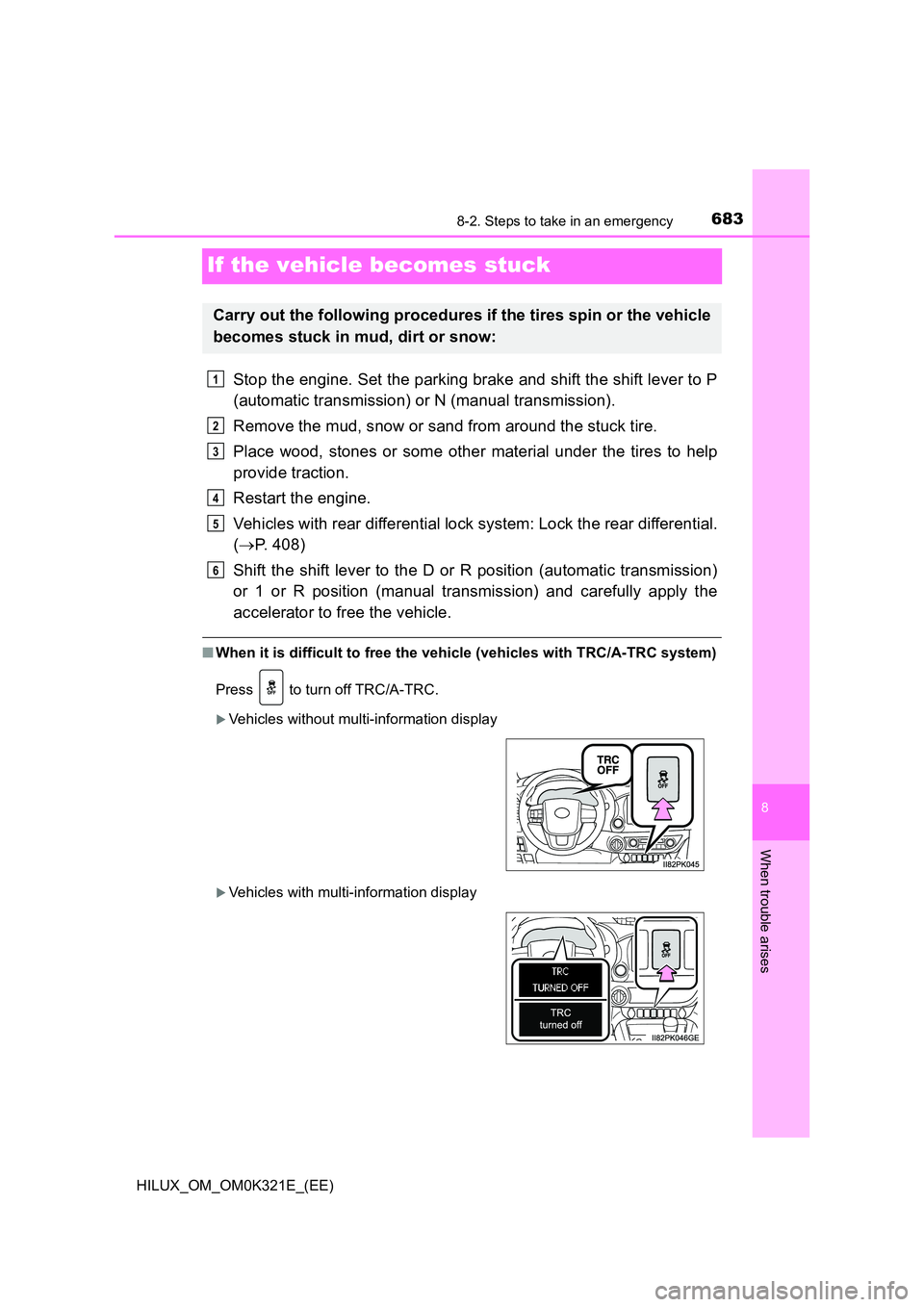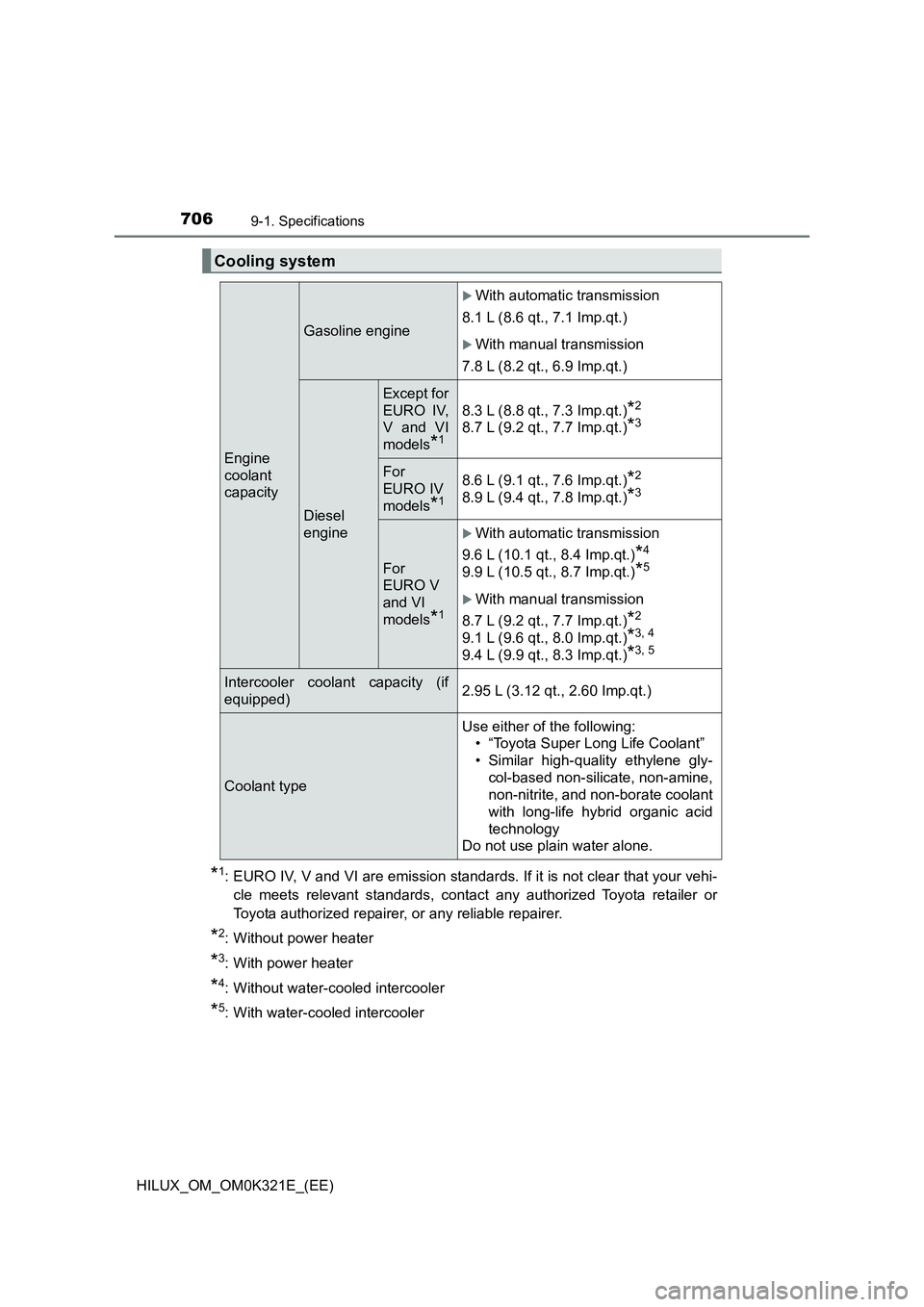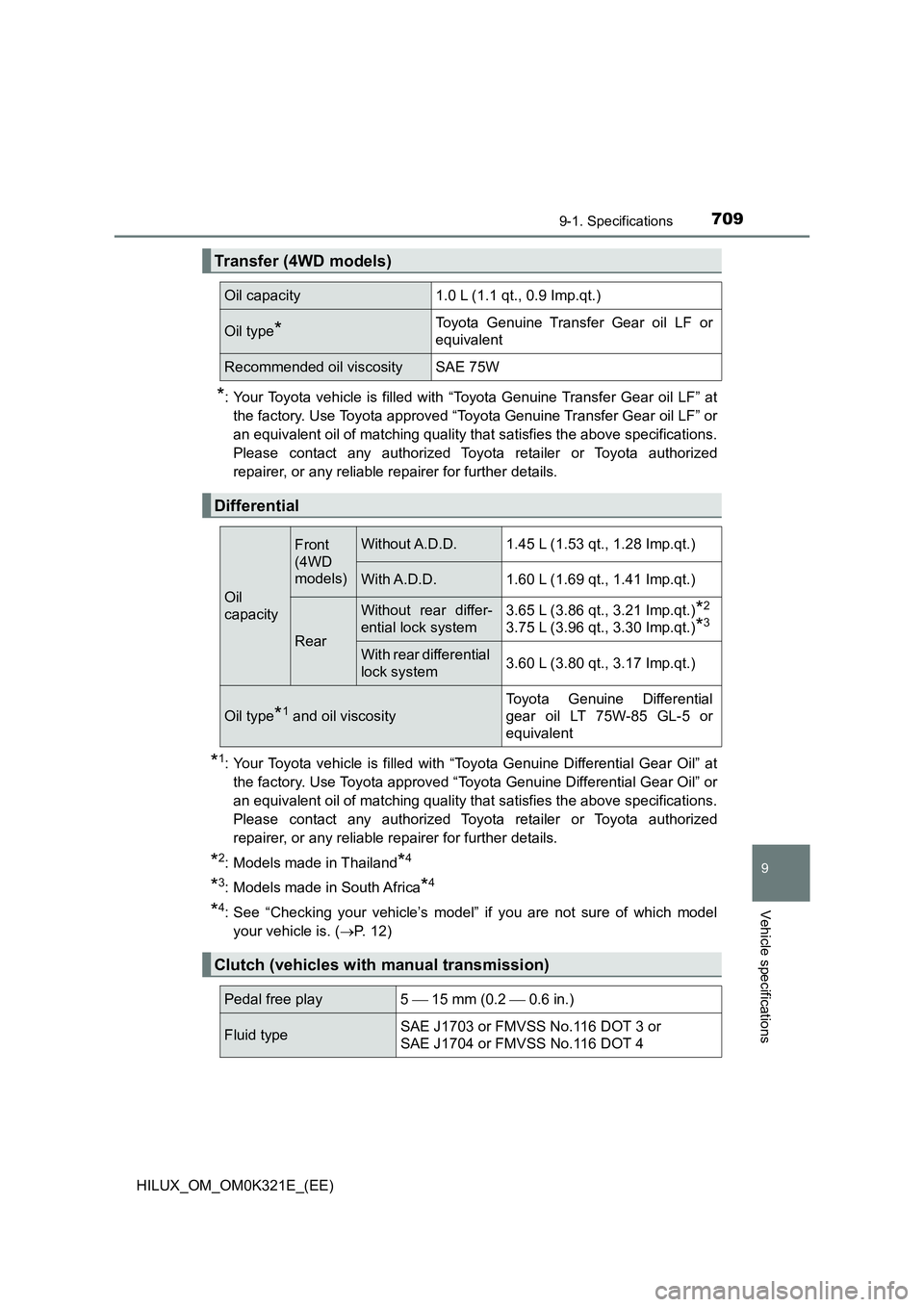2020 TOYOTA HILUX transmission
[x] Cancel search: transmissionPage 671 of 744

6718-2. Steps to take in an emergency
HILUX_OM_OM0K321E_(EE)
8
When trouble arises
■Stopping the engine
Shift the shift lever to P (automatic transmission) or N (manual transmission)
and press the engine switch as you normally do when stopping the engine.
■ Replacing the key battery
As the above procedure is a temporary measure, it is recommended that the
electronic key battery be replaced immediately when the battery is depleted.
( P. 599)
■ Alarm (vehicles with alarm for Kazakhstan, Armenia and Morocco)
Using the mechanical key to lock the doors will not set the alarm system.
If a door is unlocked using the mechanical key when the alarm system is set,
the alarm may be triggered.
■ Changing engine switch modes
Release the brake pedal (automatic transmission) or clutch pedal (manual
transmission) and press the engine switch in step above.
The engine does not start and modes will be changed each time the switch is
pressed. ( P. 288)
■ When the electronic key does not work properly
● Make sure that the smart entry & start system has not been deactivated in
the customization setting. If it is off, turn the function on.
(Customizable features: P. 718)
● Check if battery-saving mode is set. If it is set, cancel the function.
( P. 199)
3
Page 674 of 744

6748-2. Steps to take in an emergency
HILUX_OM_OM0K321E_(EE)
Once the vehicle’s engine has started, remove the jumper cables in
the exact reverse order from which they were connected.
Once the engine starts, have the vehicle inspected at any authorized
Toyota retailer or Toyota authorized repairer, or any reliable repairer
as soon as possible.
■ Starting the engine when the battery is discharged (vehicles with auto-
matic transmission)
The engine cannot be started by push-starting.
■ To prevent battery discharge
● Turn off the headlights and the audio system while the engine is off.
(Vehicles with Stop & Start system: Except when the engine is stopped due
to the Stop & Start system)
● Turn off any unnecessary electrical components when the vehicle is running
at a low speed for an extended period, such as in heavy traffic.
■ When the battery is removed or discharged
● Information stored in the ECU is cleared. When the battery is depleted, have
the vehicle inspected at any authorized Toyota retailer or Toyota authorized
repairer, or any reliable repairer.
● The power windows may not close normally. In this case, initialize the power
windows. (if equipped) ( P. 250)
■ Charging the battery
The electricity stored in the battery will discharge gradually even when the
vehicle is not in use, due to natural discharge and the draining effects of cer-
tain electrical appliances. If the vehicle is left for a long time, the battery may
discharge, and the engine may be unable to start. (The battery recharges
automatically during driving.)
■ When recharging or replacing the battery (vehicles with smart entry &
start system)
● In some cases, it may not be possible to unlock the doors using the smart
entry & start system when the battery is discharged. Use the wireless
remote control or the mechanical key to lock or unlock the doors.
● The engine may not start on the first attempt after the battery has recharged
but will start normally after the second attempt. This is not a malfunction.
● The engine switch mode is memorized by the vehicle. When the battery is
reconnected, the system will return to the mode it was in before the battery
was discharged. Before disconnecting the battery, turn the engine switch off.
If you are unsure what mode the engine switch was in before the battery dis-
charged, be especially careful when reconnecting the battery.
● Vehicles with Stop & Start system: After the battery terminals have been dis-
connected and reconnected or, the battery has been replaced, the Stop &
Start system may not automatically stop the engine for approximately 5 to
60 minutes.
6
Page 677 of 744

6778-2. Steps to take in an emergency
HILUX_OM_OM0K321E_(EE)
8
When trouble arises
WARNING
■When exchanging the battery
● When the vent plug and indicator are close to the hold down bracket, the
battery fluid (sulfuric acid) may leak.
● For information regarding battery replacement, contact any authorized
Toyota retailer or Toyota authorized repairer, or any reliable repairer.
■ To prevent damage to the vehicle (vehicles with manual transmission)
Do not pull- or push-start the vehicle as the three-way catalytic converter or
catalytic converter may overheat and become a fire hazard.
NOTICE
■ When handling jumper cables
When connecting the jumper cables, ensure that they do not become entan-
gled in the cooling fan or belt.
Page 683 of 744

6838-2. Steps to take in an emergency
HILUX_OM_OM0K321E_(EE)
8
When trouble arises
If the vehicle becomes stuck
Stop the engine. Set the parking brake and shift the shift lever to P
(automatic transmission) or N (manual transmission).
Remove the mud, snow or sand from around the stuck tire.
Place wood, stones or some other material under the tires to help
provide traction.
Restart the engine.
Vehicles with rear differential lock system: Lock the rear differential.
( P. 408)
Shift the shift lever to the D or R position (automatic transmission)
or 1 or R position (manual transmission) and carefully apply the
accelerator to free the vehicle.
■ When it is difficult to free the vehicle (vehicles with TRC/A-TRC system)
Press to turn off TRC/A-TRC.
Vehicles without multi-information display
Vehicles with multi-information display
Carry out the following procedures if the tires spin or the vehicle
becomes stuck in mud, dirt or snow:
1
2
3
4
5
6
Page 684 of 744

6848-2. Steps to take in an emergency
HILUX_OM_OM0K321E_(EE)
WARNING
■When attempting to free a stuck vehicle
If you choose to push the vehicle back and forth to free it, make sure the
surrounding area is clear to avoid striking other vehicles, objects or people.
The vehicle may also lunge forward or lunge back suddenly as it becomes
free. Use extreme caution.
■ When shifting the shift lever
For vehicles with automatic transmission, be careful not to shift the shift
lever with the accelerator pedal depressed.
This may lead to unexpected rapid acceleration of the vehicle that may
cause an accident resulting in death or serious injury.
NOTICE
■ To avoid damage to the transmission and other components
● Avoid spinning the wheels and depressing the accelerator pedal more
than necessary.
● If the vehicle remains stuck even after these procedures are performed,
the vehicle may require towing to be freed.
● Vehicles with automatic transmission: When a warning message for the
automatic transmission fluid temperature is displayed while attempting to
free a stuck vehicle, immediately remove your foot from the accelerator
pedal and wait until the warning message disappears. Otherwise, the
transmission may become damaged. ( P. 299)
Page 706 of 744

7069-1. Specifications
HILUX_OM_OM0K321E_(EE)
*1: EURO IV, V and VI are emission standards. If it is not clear that your vehi-
cle meets relevant standards, contact any authorized Toyota retailer or
Toyota authorized repairer, or any reliable repairer.
*2: Without power heater
*3: With power heater
*4: Without water-cooled intercooler
*5: With water-cooled intercooler
Cooling system
Engine
coolant
capacity
Gasoline engine
With automatic transmission
8.1 L (8.6 qt., 7.1 Imp.qt.)
With manual transmission
7.8 L (8.2 qt., 6.9 Imp.qt.)
Diesel
engine
Except for
EURO IV,
V and VI
models*1
8.3 L (8.8 qt., 7.3 Imp.qt.)*2
8.7 L (9.2 qt., 7.7 Imp.qt.)*3
For
EURO IV
models*1
8.6 L (9.1 qt., 7.6 Imp.qt.)*2
8.9 L (9.4 qt., 7.8 Imp.qt.)*3
For
EURO V
and VI
models*1
With automatic transmission
9.6 L (10.1 qt., 8.4 Imp.qt.)*4
9.9 L (10.5 qt., 8.7 Imp.qt.)*5
With manual transmission
8.7 L (9.2 qt., 7.7 Imp.qt.)*2
9.1 L (9.6 qt., 8.0 Imp.qt.)*3, 4
9.4 L (9.9 qt., 8.3 Imp.qt.)*3, 5
Intercooler coolant capacity (if
equipped)2.95 L (3.12 qt., 2.60 Imp.qt.)
Coolant type
Use either of the following:
• “Toyota Super Long Life Coolant”
• Similar high-quality ethylene gly-
col-based non-silicate, non-amine,
non-nitrite, and non-borate coolant
with long-life hybrid organic acid
technology
Do not use plain water alone.
Page 708 of 744

7089-1. Specifications
HILUX_OM_OM0K321E_(EE)
*: The fluid capacity is the quantity of reference.
If replacement is necessary, contact any authorized Toyota retailer or
Toyota authorized repairer, or any reliable repairer.
Automatic transmission
Fluid
capacity*
Gasoline engine8.5 L (9.0 qt., 7.5 Imp.qt.)
Diesel engine9.5 L (10.0 qt., 8.4 Imp.qt.)
Fluid typeToyota Genuine ATF WS
NOTICE
■ Automatic transmission fluid type
Using transmission fluid other than “Toyota Genuine ATF WS” may cause
deterioration in shift quality, locking up of your transmission accompanied
by vibration, and ultimately damage the transmission of your vehicle.
Manual transmission
Oil capacity
5-speed models 2.2 L (2.3 qt., 1.9 Imp.qt.)
6-speed
models
4WD
models 2.5 L (2.6 qt., 2.2 Imp.qt.)
Pre
Runner 2.7 L (2.9 qt., 2.4 Imp.qt.)
Oil type
TOYOTA Genuine Manual
Transmission Gear Oil API
GL-3 (GL-4) or equivalent
Recommended oil viscosity SAE 75W-90
NOTICE
■ Manual transmission gear oil
Please be aware that depending on the particular characteristics of the gear
oil used or the operating conditions, idle sound, shift feeling and/or fuel effi-
ciency may be different or affected. Toyota recommends to use “TOYOTA
Genuine Manual Transmission Gear Oil” to achieve optimal performance.
Page 709 of 744

709
9
9-1. Specifications
Vehicle specifications
HILUX_OM_OM0K321E_(EE)
*: Your Toyota vehicle is filled with “Toyota Genuine Transfer Gear oil LF” at
the factory. Use Toyota approved “Toyota Genuine Transfer Gear oil LF” or
an equivalent oil of matching quality that satisfies the above specifications.
Please contact any authorized Toyota retailer or Toyota authorized
repairer, or any reliable repairer for further details.
*1: Your Toyota vehicle is filled with “Toyota Genuine Differential Gear Oil” at
the factory. Use Toyota approved “Toyota Genuine Differential Gear Oil” or
an equivalent oil of matching quality that satisfies the above specifications.
Please contact any authorized Toyota retailer or Toyota authorized
repairer, or any reliable repairer for further details.
*2: Models made in Thailand*4
*3: Models made in South Africa*4
*4: See “Checking your vehicle’s model” if you are not sure of which model
your vehicle is. ( P. 1 2 )
Transfer (4WD models)
Oil capacity1.0 L (1.1 qt., 0.9 Imp.qt.)
Oil type*Toyota Genuine Transfer Gear oil LF or
equivalent
Recommended oil viscositySAE 75W
Differential
Oil
capacity
Front
(4WD
models)
Without A.D.D.1.45 L (1.53 qt., 1.28 Imp.qt.)
With A.D.D.1.60 L (1.69 qt., 1.41 Imp.qt.)
Rear
Without rear differ-
ential lock system
3.65 L (3.86 qt., 3.21 Imp.qt.)*2
3.75 L (3.96 qt., 3.30 Imp.qt.)*3
With rear differential
lock system3.60 L (3.80 qt., 3.17 Imp.qt.)
Oil type*1 and oil viscosity
Toyota Genuine Differential
gear oil LT 75W-85 GL-5 or
equivalent
Clutch (vehicles with manual transmission)
Pedal free play 5 15 mm (0.2 0.6 in.)
Fluid type SAE J1703 or FMVSS No.116 DOT 3 or
SAE J1704 or FMVSS No.116 DOT 4